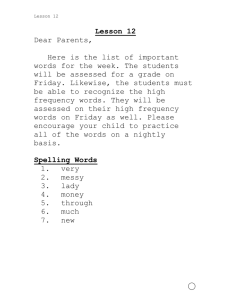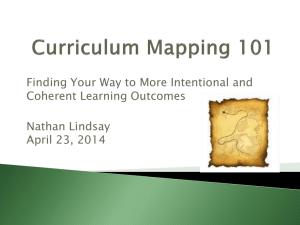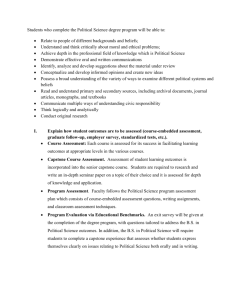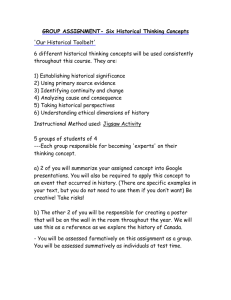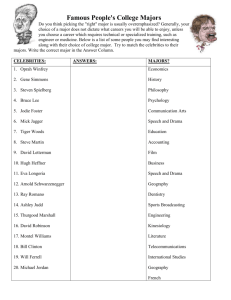Assessing Assessment on the Program Level
advertisement
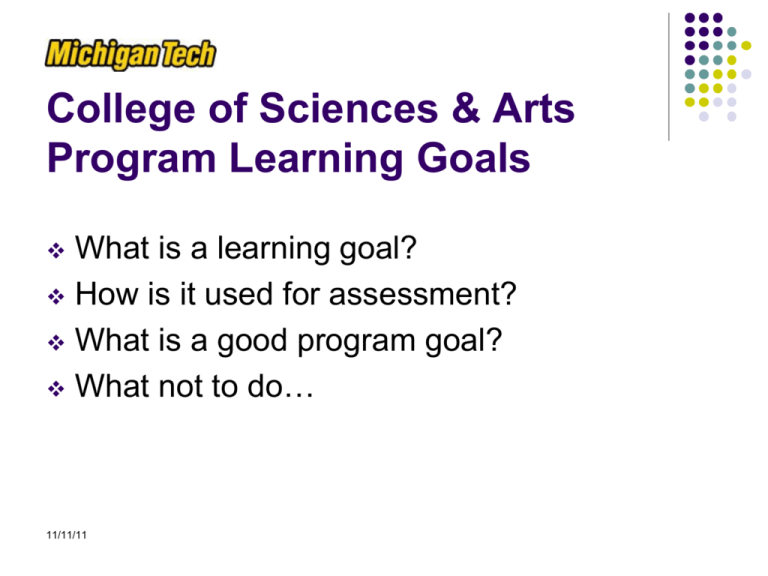
College of Sciences & Arts Program Learning Goals What is a learning goal? How is it used for assessment? What is a good program goal? What not to do… 11/11/11 CSA Assessment Process 1. 2. 3. 4. 5. Develop learning goals for each degree program Map them onto University Goals using spreadsheet. Map the learning goals onto the curriculum: Identify which courses in the program meet which learning goals. This will help you identify where/how it would be assessed. Assess two learning goals in courses using existing data and rubrics. Close the Loop: Identify gaps/deficiencies take action Repeat. What Is Assessment? Assessment is the ongoing process of: 1. Establishing clear, measurable expected outcomes of student learning -- aka learning goals 2. Ensuring that students have sufficient opportunities to achieve those outcomes -- mapping to the curriculum 3. Systematically gathering, analyzing, and interpreting evidence to determine how well student learning matches our expectations -- conducting an assessment 4. Using the resulting information to understand and improve student learning -- completing the loop Suskie & Banta, Assessing Student Learning: A Common Sense Guide, 2nd ed., 2009 Coaching Assessment: Student Learning Outcomes Avoiding Garbage In / Garbage Out WEAVE Online Seminar Susan Hatfield Professor, Communication Studies Winona State University Visiting Scholar, Higher Learning Commission SHatfield@winona.edu Guiding Assumption: Assessing student learning at the program level starts with well written student learning outcomes. There’s nowhere for a program to go if they are starting with poorly written student learning outcomes. Language of Assessment (Why everyone is so confused) Goals Objectives Outcomes Competencies Proficiencies Dispositions Language of Assessment A. General skill or knowledge category / statement GOAL B. Specific accomplishments to be achieved STUDENT LEARNING OUTCOME C. The key elements related to the accomplishment of the outcome COMPONENTS – What are you looking for in student work to be able to tell if they “get it”; aka grading criteria. Assessing Student Learning Outcomes What the student will √ Know √ Do ….at the end of the course or program Students will be able to <<action verb>> <<something>> COMPREHENSION ANALYSIS EVALUATION APPLICATION SYNTHESIS KNOWLEDGE Cite Count Define Draw Identify List Name Point Quote Read Recite Record Repeat Select State Tabulate Tell Trace Underline Associate Classify Compare Compute Contrast Differentiate Discuss Distinguish Estimate Explain Express Extrapolate Interpolate Locate Predict Report Restate Review Tell Translate Apply Calculate Classify Demonstrate Determine Dramatize Employ Examine Illustrate Interpret Locate Operate Order Practice Report Restructure Schedule Sketch Solve Translate Use Write Advanced Course / Program outcomes Analyze Appraise Calculate Categorize Classify Compare Debate Diagram Differentiate Distinguish Examine Experiment Inspect Inventory Question Separate Summarize Test Arrange Assemble Collect Compose Construct Create Design Formulate Integrate Manage Organize Plan Prepare Prescribe Produce Propose Specify Synthesize Write Appraise Assess Choose Compare Criticize Determine Estimate Evaluate Grade Judge Measure Rank Rate Recommend Revise Score Select Standardize Test Validate “Students will be able to…” NOT • Curriculum emphasizes xyz • Institution values xyz • Institution prepares students for xyz. • Students are exposed to xyz. • Students participate in xyz. Walvoord, Assessment Clear & Simple, Jossey-Bass, 2nd ed. 2010 Goal Outcome Outcome Outcome Outcome Outcome Learning object component component component Evaluative elements Communication Write Relate Lab report Speak mechanics style organization Listen Participate Communication Writing Listening Speaking Relating Teamwork Sales Presentation Content Organization Delivery TIP: It is impossible to assess an outcome if there is no agreement on what that outcome means. teacher4 teacher2 teacher1 teacher3 teacher5 Speaking eye contact style appearance gestures rate evidence volume poise conclusion sources transitions examples verbal variety organization attention getter Example #1 Gather factual information and apply it to a given problem in a manner that is relevant, clear, comprehensive, and conscious of possible bias in the information selected BETTER: Students will apply factual information to a problem COMPONENTS: Relevance Clarity Comprehensiveness Aware of Bias Example #2 Imagine and seek out a variety of possible goals, assumptions, interpretations, or perspectives which can give alternative meanings or solutions to given situations or problems BETTER: Students will provide alternative solutions to situations or problems COMPONENTS: Variety of assumptions, perspectives, interpretations Analysis of comparative advantage Rubrics • Analytical tool • Numerous components which you want to assess individually • Summative Developmental • www.winona.edu/air/rubrics.htm • Analytical / Summative Rubric Outcome: Components Exceeds expectations Analytical / Developmental Rubric Outcome: Components sophistication LEAP VALUE Rubrics Assessing SOME TIPS 1. 2. 3. Programs don’t need a lot of outcomes. 4-7 is enough. The more complex the outcome, the harder it will be to assess. Stay away from multiple <action verbs> and multiple <somethings>. So, let’s look at your goals. QUESTIONS? CSA Assessment Process 1. 2. 3. 4. 5. Develop learning goals for each degree program Map them onto University Goals using spreadsheet. Map the learning goals onto the curriculum: Identify which courses in the program meet which learning goals. This will help you identify where/how it would be assessed. Assess two learning goals in courses using existing data and rubrics. Close the Loop: Identify gaps/deficiencies take action Repeat. Levels of Learning Outcomes • • • • • University/Institution General Education Academic Programs Courses Classes Mission Vision University Student Learning Goals General Education Student Life & Development Academic Programs External Agencies Institutional level: Students will communicate effectively in writing to a variety of audiences. Program level: Students who complete the business major will communicate effectively to professional and lay audiences using the common business formats. Course Level: Students who complete this finance course will be able to write xyz financial reports. Walvoord, Assessment Clear & Simple, JosseyBass, 2nd ed. 2010 University Learning Goals Your Degree Program Learning Goals Outcomes Assessed by Your Department 1. Disciplinary Knowledge. Students demonstrate a depth of knowledge in one area/ discipline, as well as a breadth of knowledge that (1) enables adaptability and flexibility as knowledge grows and changes, and (2) recognizes linkages/complementarity to other areas/disciplines. Goal 1. All majors will demonstrate a fundamental knowledge of XX. Goal 1 is assessed through the Major Field Test in XX. Gaps in learning and assessment 2. Knowledge of human cultures and the physical Goal 1. All majors will demonstrate a fundamental Goal 1 is assessed through the Major Field Test in XX. and natural world. Students demonstrate knowledge of XX. knowledge of human cultures and the physical and natural world. This is accomplished by studying science, mathematics, social sciences and humanities, and engagement with contemporary and enduring “big questions.” 3. Global Literacy. Students will be able to interact in meaningful ways with people from other cultures. This will be accomplished by acquisition of global knowledge and competencies through the study of languages, cultures, history, geography, etc. Not assessed within Department 4. Critical & Creative Thinking. Students will be Goal 2. All majors will have well developed able to think critically and creatively, as critical thinking and problem solving skills. demonstrated by their broad, adaptable and versatile use of reasoning, logic, and evidence to access and evaluate information and solve complex problems both independently and in groups. 5. Communication. Students will be able to communicate effectively, orally, in writing and in new media, to a wide variety of audiences. Goal 3. All majors will have a fundamental knowledge of the Scientific Method of Investigation. OR Goal 3. All majors will be able to design an effective experimental protocol, including statistical analysis, to investigate a problem in their area of interest or expertise. Goal 4. All majors will be able to write a scientific paper in the style for publication based on a set of experimentally derived data. 6. Information Literacy. Students will be able to Goal 5. All majors will be able to find, interpret identify the need for information, procure and and analyze information from varied sources evaluate information, and subsequently revise their including the primary literature. strategy for obtaining information. Students will access and apply information in an ethical and legal manner. Goal 2 is addressed through the score for assessment indicator #9 of the Major Field Test. Goal 3 is assessed through analysis of the experimental design reports required in XX4470 (xxstatistics). Goal 4 is assessed through primary trait analysis of lab reports from XX1010, XX3400 and XX4820. We assess students' ability to communicate orally by faculty observation of student oral presentations in XX4510 (Senior Essay). Goal 5 is assessed through primary trait evaluations of both the oral presentations and written reports in XX4510 (Senior Essay). 7. Technology. Students will demonstrate Goal 6. All majors will have developed basic knowledge of technology and its implications in laboratory skills in their area of interest or society, and be able to design and/or use technology expertise. for creative activities or innovative solutions to problems. Not assessed. 8. Values and Civic Engagement. Students will be able to address conflicting moral, ethical, and legal questions, and identify and develop a personal sense of ethical responsibility for the broader impact of their actions on science and a sustainable society. Not assesed Mapping to University Goals • • • • Where do your program goals “fit” the university goals? Not every university goal requires a program goal. You might have a program goal that is not covered by the university goals, e.g. teamwork. Your program goals should stand on their own and be stated at the appropriate level. Let’s compare your goals to university goals. QUESTIONS? CSA Assessment Process 1. 2. 3. 4. 5. Develop learning goals for each degree program Map them onto University Goals using spreadsheet. Map the learning goals onto the curriculum: Identify which courses in the program meet which learning goals. This will help you identify where/how it would be assessed. Assess two learning goals in courses using existing data and rubrics. Close the Loop: Identify gaps/deficiencies take action Repeat. Assessment at the academic program level An academic program should be integrated -more than a collection of courses. - but the program is actualized through the curriuculum. Suskie & Banta, Assessing Student Learning: A Common Sense Guide, 2nd ed., 2009 TIP: The curriculum should support the learning outcomes Use the curriculum map to identify assessment points • Program: Outcomes that the program has defined for all students graduating in that program. Program goals are broader than courses. Department website. • • Course: Outcomes that are shared across all faculty teaching sections of the same course. Course catalog description • • Program goal: design appropriate approaches to a variety of problems in the discipline Course goal: solve a specific kind of problem Class: Outcomes individual faculty have developed for their class. On syllabus Program Level Student Learning Outcomes 1 1xx K A S A A S S A K K S S A K K A A K 4 5 2xx 2xx 2xx 3xx 3xx 3xx 4xx Capstone A K 2 3 1xx A S S 6 K K A A S 7 S A A S S K= Knowledge/Comprehension; A= Application / Analysis; S= Synthesis /Evaluation Program Level Student Learning Outcomes 1 1xx 1xx 2xx A K K 2 2xx A 2xx 3xx 3xx A A 3xx 4xx Capstone S A A S S A K 3 K 4 Build K a curriculum K 5 K S K A S S 6 K K K A S 7 S A A S S K= Knowledge/Comprehension; A= Application / Analysis; S= Synthesis /Evaluation Program Level Student Learning Outcomes 1 1xx K 2xx A 2xx 3xx 3xx A A 3xx 4xx Capstone S A A S S A K K Analyze Curriculum K Diagnose KLearning S 4 5 2xx A K 2 3 1xx K K A S S 6 K K K A S 7 S A A S S K= Knowledge/Comprehension; A= Application / Analysis; S= Synthesis /Evaluation Program Level Student Learning Outcomes 1 1xx 2xx 2xx A K K 2 3 1xx A 2xx 3xx A 3xx 3xx 4xx Capstone A A K K S S K K 4 5 S K 6 K K A 7 S A A A S S K= Knowledge/Comprehension; A= Application / Analysis; S= Synthesis /Evaluation Program Level Student Learning Outcomes 1 1xx 2xx 2xx A K K 2 3 1xx A 2xx 3xx A 3xx 3xx 4xx Capstone A A K K S S K K 4 5 S K 6 K K A 7 S A A A S S K= Knowledge/Comprehension; A= Application / Analysis; S= Synthesis /Evaluation Program Level Student Learning Outcomes 1 1xx K 2xx A 2xx 3xx 3xx A A 3xx 4xx Capstone S A A S S A K K K DiagnoseKLearning S 4 5 2xx A K 2 3 1xx K K A S S 6 K K K A S 7 S A A S S K= Knowledge/Comprehension; A= Application / Analysis; S= Synthesis /Evaluation Assessing Learning embedded – direct measure • • • • • • • • • Test – course or field test Project Presentation Performance Case Study Exhibit Internship or field experience Portfolio Capstone experience TIP: One data point is not a pattern of evidence no matter how soon the accreditors are coming Some comments Don’t try to pack too much into one goal – understand + apply + present… and try not to use “subgoals” – a, b, c…. The “knowledge” goal should not describe the curriculum. The goals should drive the curriculum, not be a description of the curriculum. Think of the goals as telling your students your expectations. If they decide to major in your program, this is what you expect them to learn. If you have multiple degrees in your department, how are these expectations different? Think about how you would assess any of these goals with direct measures. If there is no way to measure it, or it is too complicated to measure, either it is not a good goal, or you will need to do something differently in your program. CSA Assessment Process 1. 2. 3. 4. 5. Develop learning goals for each degree program Map them onto University Goals using spreadsheet. Map the learning goals onto the curriculum: Identify which courses in the program meet which learning goals. This will help you identify where/how it would be assessed. Assess two learning goals in courses using existing data and rubrics. Close the Loop: Identify gaps/deficiencies take action Repeat. University Learning Goals Your Degree Program Learning Goals Outcomes Assessed by Your Department 1. Disciplinary Knowledge. Students demonstrate a depth of knowledge in one area/ discipline, as well as a breadth of knowledge that (1) enables adaptability and flexibility as knowledge grows and changes, and (2) recognizes linkages/complementarity to other areas/disciplines. Goal 1. All majors will demonstrate a fundamental knowledge of XX. Goal 1 is assessed through the Major Field Test in XX. Gaps in learning and assessment 2. Knowledge of human cultures and the physical Goal 1. All majors will demonstrate a fundamental Goal 1 is assessed through the Major Field Test in XX. and natural world. Students demonstrate knowledge of XX. knowledge of human cultures and the physical and natural world. This is accomplished by studying science, mathematics, social sciences and humanities, and engagement with contemporary and enduring “big questions.” 3. Global Literacy. Students will be able to interact in meaningful ways with people from other cultures. This will be accomplished by acquisition of global knowledge and competencies through the study of languages, cultures, history, geography, etc. Not assessed within Department 4. Critical & Creative Thinking. Students will be Goal 2. All majors will have well developed able to think critically and creatively, as critical thinking and problem solving skills. demonstrated by their broad, adaptable and versatile use of reasoning, logic, and evidence to access and evaluate information and solve complex problems both independently and in groups. 5. Communication. Students will be able to communicate effectively, orally, in writing and in new media, to a wide variety of audiences. Goal 3. All majors will have a fundamental knowledge of the Scientific Method of Investigation. OR Goal 3. All majors will be able to design an effective experimental protocol, including statistical analysis, to investigate a problem in their area of interest or expertise. Goal 4. All majors will be able to write a scientific paper in the style for publication based on a set of experimentally derived data. 6. Information Literacy. Students will be able to Goal 5. All majors will be able to find, interpret identify the need for information, procure and and analyze information from varied sources evaluate information, and subsequently revise their including the primary literature. strategy for obtaining information. Students will access and apply information in an ethical and legal manner. Goal 2 is addressed through the score for assessment indicator #9 of the Major Field Test. Goal 3 is assessed through analysis of the experimental design reports required in XX4470 (xxstatistics). Goal 4 is assessed through primary trait analysis of lab reports from XX1010, XX3400 and XX4820. We assess students' ability to communicate orally by faculty observation of student oral presentations in XX4510 (Senior Essay). Goal 5 is assessed through primary trait evaluations of both the oral presentations and written reports in XX4510 (Senior Essay). 7. Technology. Students will demonstrate Goal 6. All majors will have developed basic knowledge of technology and its implications in laboratory skills in their area of interest or society, and be able to design and/or use technology expertise. for creative activities or innovative solutions to problems. Not assessed. 8. Values and Civic Engagement. Students will be able to address conflicting moral, ethical, and legal questions, and identify and develop a personal sense of ethical responsibility for the broader impact of their actions on science and a sustainable society. Not assesed

